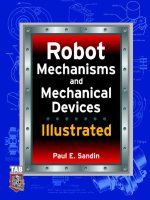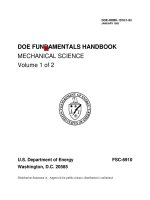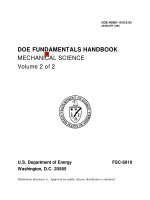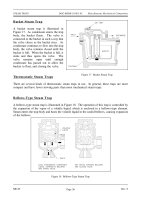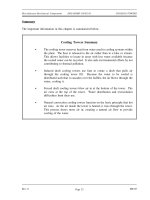Mechanical Science Handbooks P1 ppsx
Bạn đang xem bản rút gọn của tài liệu. Xem và tải ngay bản đầy đủ của tài liệu tại đây (1.4 MB, 30 trang )
DOE-HDBK-1018/1-93
JANUARY 1993
DOE FUNDAMENTALS HANDBOOK
MECHANICAL SCIENCE
Volume 1 of 2
U.S. Department of Energy FSC-6910
Washington, D.C. 20585
Distribution Statement A. Approved for public release; distribution is unlimited.
This document has been reproduced directly from the best available copy.
Available to DOE and DOE contractors from the Office of Scientific and
Technical Information. P.O. Box 62, Oak Ridge, TN 37831.
Available to the public from the National Technical Information Services, U.S.
Department of Commerce, 5285 Port Royal., Springfield, VA 22161.
Order No. DE93012178
DOE-HDBK-1018/1-93
MECHANICAL SCIENCE
Rev. 0 ME
ABSTRACT
The Mechanical Science Handbook was developed to assist nuclear facility operating
contractors in providing operators, maintenance personnel, and the technical staff with the necessary
fundamentals training to ensure a basic understanding of mechanical components and mechanical
science. The handbook includes information on diesel engines, heat exchangers, pumps, valves, and
miscellaneous mechanical components. This information will provide personnel with a foundation
for understanding the construction and operation of mechanical components that are associated with
various DOE nuclear facility operations and maintenance.
Key Words: Training Material, Diesel Engine, Heat Exchangers, Pumps, Valves
DOE-HDBK-1018/1-93
MECHANICAL SCIENCE
Rev. 0 ME
FOREWORD
The Department of Energy (DOE) Fundamentals Handbooks consist of ten academic
subjects, which include Mathematics; Classical Physics; Thermodynamics, Heat Transfer, and Fluid
Flow; Instrumentation and Control; Electrical Science; Material Science; Mechanical Science;
Chemistry; Engineering Symbology, Prints, and Drawings; and Nuclear Physics and Reactor
Theory. The handbooks are provided as an aid to DOE nuclear facility contractors.
These handbooks were first published as Reactor Operator Fundamentals Manuals in 1985
for use by DOE category A reactors. The subject areas, subject matter content, and level of detail
of the Reactor Operator Fundamentals Manuals were determined from several sources. DOE
Category A reactor training managers determined which materials should be included, and served
as a primary reference in the initial development phase. Training guidelines from the commercial
nuclear power industry, results of job and task analyses, and independent input from contractors and
operations-oriented personnel were all considered and included to some degree in developing the
text material and learning objectives.
The DOE Fundamentals Handbooks represent the needs of various DOE nuclear facilities'
fundamental training requirements. To increase their applicability to nonreactor nuclear facilities,
the Reactor Operator Fundamentals Manual learning objectives were distributed to the Nuclear
Facility Training Coordination Program Steering Committee for review and comment. To update
their reactor-specific content, DOE Category A reactor training managers also reviewed and
commented on the content. On the basis of feedback from these sources, information that applied
to two or more DOE nuclear facilities was considered generic and was included. The final draft of
each of the handbooks was then reviewed by these two groups. This approach has resulted in
revised modular handbooks that contain sufficient detail such that each facility may adjust the
content to fit their specific needs.
Each handbook contains an abstract, a foreword, an overview, learning objectives, and text
material, and is divided into modules so that content and order may be modified by individual DOE
contractors to suit their specific training needs. Each handbook is supported by a separate
examination bank with an answer key.
The DOE Fundamentals Handbooks have been prepared for the Assistant Secretary for
Nuclear Energy, Office of Nuclear Safety Policy and Standards, by the DOE Training Coordination
Program. This program is managed by EG&G Idaho, Inc.
DOE-HDBK-1018/1-93
MECHANICAL SCIENCE
Rev. 0 ME
OVERVIEW
The Department of Energy Fundamentals Handbook entitled Mechanical Science was
prepared as an information resource for personnel who are responsible for the operation of the
Department's nuclear facilities. Almost all processes that take place in the nuclear facilities involve
the use of mechanical equipment and components. A basic understanding of mechanical science is
necessary for DOE nuclear facility operators, maintenance personnel, and the technical staff to
safely operate and maintain the facility and facility support systems. The information in the
handbook is presented to provide a foundation for applying engineering concepts to the job. This
knowledge will help personnel more fully understand the impact that their actions may have on the
safe and reliable operation of facility components and systems.
The Mechanical Science handbook consists of five modules that are contained in two
volumes. The following is a brief description of the information presented in each module of the
handbook.
Volume 1 of 2
Module 1 - Diesel Engine Fundamentals
Provides information covering the basic operating principles of 2-cycle and 4-cycle
diesel engines. Includes operation of engine governors, fuel ejectors, and typical
engine protective features.
Module 2 - Heat Exchangers
Describes the construction of plate heat exchangers and tube and shell heat
exchangers. Describes the flow patterns and temperature profiles in parallel flow,
counter flow, and cross flow heat exchangers.
Module 3 - Pumps
Explains the operation of centrifugal and positive displacement pumps. Topics
include net positive suction head, cavitation, gas binding, and pump characteristic
curves.
DOE-HDBK-1018/1-93
MECHANICAL SCIENCE
Rev. 0 ME
OVERVIEW (Cont.)
Volume 2 of 2
Module 4 - Valves
Introduces the functions of the basic parts common to most types of valves.
Provides information on applications of many types of valves. Types of valves
covered include gate valves, globe valves, ball valves, plug valves, diaphragm
valves, reducing valves, pinch valves, butterfly valves, needle valves, check valves,
and safety/relief valves.
Module 5 - Miscellaneous Mechanical Components
Provides information on significant mechanical devices that have widespread
application in nuclear facilities but do not fit into the categories of components
covered by the other modules. These include cooling towers, air compressors,
demineralizers, filters, strainers, etc.
The information contained in this handbook is not all-encompassing. An attempt to present
the entire subject of mechanical science would be impractical. However, the Mechanical Science
handbook presents enough information to provide the reader with the fundamental knowledge
necessary to understand the advanced theoretical concepts presented in other subject areas, and to
understand basic system and equipment operation.
Department of Energy
Fundamentals Handbook
MECHANICAL SCIENCE
Module 1
Diesel Engine Fundamentals
Diesel Engine Fundamentals DOE-HDBK-1018/1-93 TABLE OF CONTENTS
TABLE OF CONTENTS
LIST OF FIGURES ii
LIST OF TABLES iv
REFERENCES v
OBJECTIVES vi
DIESEL ENGINES 1
Introduction 1
History 2
Diesel Engines 2
Major Components of a Diesel Engine 3
Diesel Engine Support Systems 12
Exhaust System 16
Operational Terminology 17
Summary 20
FUNDAMENTALS OF THE DIESEL CYCLE 21
The Basic Diesel Cycles 21
The Four-Stoke Cycle 22
The Two-Stroke Cycle 25
Summary 28
DIESEL ENGINE SPEED, FUEL CONTROLS,
AND PROTECTION 30
Engine Control 30
Fuel Injectors 30
Governor 34
Operation of a Governor 34
Starting Circuits 38
Engine Protection 38
Summary 40
Rev. 0 ME-01
Page i
LIST OF FIGURES DOE-HDBK-1018/1-93 Diesel Engine Fundamentals
LIST OF FIGURES
Figure 1 Example of a Large Skid-Mounted, Diesel-Driven Generator 2
Figure 2 Cutaway of a Four-Stroke Supercharged Diesel Engine 4
Figure 3 Cross Section of a V-type Four Stroke Diesel Engine 5
Figure 4 The Cylinder Block 6
Figure 5 Diesel Engine Wet Cylinder Sleeve 7
Figure 6 Piston and Piston Rod 7
Figure 7 Diesel Engine Crankshaft and Bearings 9
Figure 8 Diesel Engine Valve 10
Figure 9 Diesel Engine Camshaft and Drive Gear 10
Figure 10 Diesel Engine Valve Train 11
Figure 11 Diesel Engine Cooling System 12
Figure 12 Diesel Engine Internal Lubrication System 13
Figure 13 Diesel Engine Fuel Flowpath 14
Figure 14 Oil Bath Air Filter 15
Figure 15 Compression Ratio 18
Figure 16 Scavenging and Intake 22
Figure 17 Compression 23
Figure 18 Fuel Injection 24
Figure 19 Power 24
Figure 20 Exhaust 25
Figure 21 2-Stroke Exhaust 26
ME-01 Rev. 0
Page ii
Diesel Engine Fundamentals DOE-HDBK-1018/1-93 LIST OF FIGURES
LIST OF FIGURES (Cont.)
Figure 22 2-Stroke Intake 26
Figure 23 2-Stroke Compression 27
Figure 24 2-Stroke Fuel Injection 27
Figure 25 2-Stroke Power 27
Figure 26 Fuel Injector Cutaway 31
Figure 27 Fuel Injector Plunger 33
Figure 28 Simplified Mechanical-Hydraulic Governor 35
Figure 29 Cutaway of a Woodward Governor 36
Rev. 0 ME-01
Page iii
LIST OF TABLES DOE-HDBK-1018/1-93 Diesel Engine Fundamentals
LIST OF TABLES
NONE
ME-01 Rev. 0
Page iv
Diesel Engine Fundamentals DOE-HDBK-1018/1-93 REFERENCES
REFERENCES
Benson & Whitehouse, Internal Combustion Engines, Pergamon.
Cheremisinoff, N. P., Fluid Flow, Pumps, Pipes and Channels, Ann Arbor Science.
Scheel, Gas and Air Compression Machinery, McGraw/Hill.
Skrotzki and Vopat, Steam and Gas Turbines, McGraw/Hill.
Stinson, Karl W., Diesel Engineering Handbook, Diesel Publications Incorporated.
Rev. 0 ME-01
Page v
OBJECTIVES DOE-HDBK-1018/1-93 Diesel Engine Fundamentals
TERMINAL OBJECTIVE
1.0 Without references, DESCRIBE the components and theory of operation for a diesel
engine.
ENABLING OBJECTIVES
1.1 DEFINE the following diesel engine terms:
a. Compression ratio
b. Bore
c. Stroke
d. Combustion chamber
1.2 Given a drawing of a diesel engine, IDENTIFY the following:
a. Piston/rod
b. Cylinder
c. Blower
d. Crankshaft
e. Intake ports or valve(s)
f. Exhaust ports or valve(s)
g. Fuel injector
1.3 EXPLAIN how a diesel engine converts the chemical energy stored in the diesel fuel into
mechanical energy.
1.4 EXPLAIN how the ignition process occurs in a diesel engine.
1.5 EXPLAIN the operation of a 4-cycle diesel engine to include when the following events
occur during a cycle:
a. Intake
b. Exhaust
c. Fuel injection
d. Compression
e. Power
ME-01 Rev. 0
Page vi
Diesel Engine Fundamentals DOE-HDBK-1018/1-93 OBJECTIVES
ENABLING OBJECTIVES (Cont.)
1.6 EXPLAIN the operation of a 2-cycle diesel engine, including when the following events
occur during a cycle:
a. Intake
b. Exhaust
c. Fuel injection
d. Compression
e. Power
1.7 DESCRIBE how the mechanical-hydraulic governor on a diesel engine controls engine
speed.
1.8 LIST five protective alarms usually found on mid-sized and larger diesel engines.
Rev. 0 ME-01
Page vii
OBJECTIVES DOE-HDBK-1018/1-93 Diesel Engine Fundamentals
Intentionally Left Blank
ME-01 Rev. 0
Page viii
Diesel Engine Fundamentals DOE-HDBK-1018/1-93 DIESEL ENGINES
DIESEL ENGINES
One of the most common prime movers is the diesel engine. Before gaining an
understanding of how the engine operates a basic understanding of the engine's
components must be gained. This chapter reviews the major components of a
generic diesel engine.
EO 1.1 DEFINE the following diesel engine terms:
a. Compression ratio
b. Bore
c. Stroke
d. Combustion chamber
EO 1.2 Given a drawing of a diesel engine, IDENTIFY the following:
a. Piston/rod
b. Cylinder
c. Blower
d. Crankshaft
e. Intake ports or valve(s)
f. Exhaust ports or valve(s)
g. Fuel injector
Introduction
Most DOE facilities require some type of prime mover to supply mechanical power for pumping,
electrical power generation, operation of heavy equipment, and to act as a backup electrical
generator for emergency use during the loss of the normal power source. Although several types
of prime movers are available (gasoline engines, steam and gas turbines), the diesel engine is
the most commonly used. Diesel engines provide a self-reliant energy source that is available
in sizes from a few horsepower to 10,000 hp. Figure 1 provides an illustration of a common
skid-mounted, diesel-driven generator. Relatively speaking, diesel engines are small,
inexpensive, powerful, fuel efficient, and extremely reliable if maintained properly.
Because of the widespread use of diesel engines at DOE facilities, a basic understanding of the
operation of a diesel engine will help ensure they are operated and maintained properly. Due to
the large variety of sizes, brands, and types of engines in service, this module is intended to
provide the fundamentals and theory of operation of a diesel engine. Specific information on
a particular engine should be obtained from the vendor's manual.
Rev. 0 ME-01
Page 1
DIESEL ENGINES DOE-HDBK-1018/1-93 Diesel Engine Fundamentals
History
Figure 1 Example of a Large Skid-Mounted, Diesel-Driven Generator
The modern diesel engine came about as the result of the internal combustion principles first
proposed by Sadi Carnot in the early 19th century. Dr. Rudolf Diesel applied Sadi Carnot's
principles into a patented cycle or method of combustion that has become known as the "diesel"
cycle. His patented engine operated when the heat generated during the compression of the air
fuel charge caused ignition of the mixture, which then expanded at a constant pressure during
the full power stroke of the engine.
Dr. Diesel's first engine ran on coal dust and used a compression pressure of 1500 psi to
increase its theoretical efficiency. Also, his first engine did not have provisions for any type of
cooling system. Consequently, between the extreme pressure and the lack of cooling, the engine
exploded and almost killed its inventor. After recovering from his injuries, Diesel tried again
using oil as the fuel, adding a cooling water jacket around the cylinder, and lowering the
compression pressure to approximately 550 psi. This combination eventually proved successful.
Production rights to the engine were sold to Adolphus Bush, who built the first diesel engines
for commercial use, installing them in his St. Louis brewery to drive various pumps.
Diesel Engines
A diesel engine is similar to the gasoline engine used in most cars. Both engines are internal
combustion engines, meaning they burn the fuel-air mixture within the cylinders. Both are
reciprocating engines, being driven by pistons moving laterally in two directions. The majority
of their parts are similar. Although a diesel engine and gasoline engine operate with similar
components, a diesel engine, when compared to a gasoline engine of equal horsepower, is
heavier due to stronger, heavier materials used to withstand the greater dynamic forces from the
higher combustion pressures present in the diesel engine.
ME-01 Rev. 0
Page 2
Diesel Engine Fundamentals DOE-HDBK-1018/1-93 DIESEL ENGINES
The greater combustion pressure is the result of the higher compression ratio used by diesel
engines. The compression ratio is a measure of how much the engine compresses the gasses in
the engine's cylinder. In a gasoline engine the compression ratio (which controls the
compression temperature) is limited by the air-fuel mixture entering the cylinders. The lower
ignition temperature of gasoline will cause it to ignite (burn) at a compression ratio of less than
10:1. The average car has a 7:1 compression ratio. In a diesel engine, compression ratios
ranging from 14:1 to as high as 24:1 are commonly used. The higher compression ratios are
possible because only air is compressed, and then the fuel is injected. This is one of the factors
that allows the diesel engine to be so efficient. Compression ratio will be discussed in greater
detail later in this module.
Another difference between a gasoline engine and a diesel engine is the manner in which engine
speed is controlled. In any engine, speed (or power) is a direct function of the amount of fuel
burned in the cylinders. Gasoline engines are self-speed-limiting, due to the method the engine
uses to control the amount of air entering the engine. Engine speed is indirectly controlled by
the butterfly valve in the carburetor. The butterfly valve in a carburetor limits the amount of
air entering the engine. In a carburetor, the rate of air flow dictates the amount of gasoline that
will be mixed with the air. Limiting the amount of air entering the engine limits the amount of
fuel entering the engine, and, therefore, limits the speed of the engine. By limiting the amount
of air entering the engine, adding more fuel does not increase engine speed beyond the point
where the fuel burns 100% of the available air (oxygen).
Diesel engines are not self-speed-limiting because the air (oxygen) entering the engine is always
the maximum amount. Therefore, the engine speed is limited solely by the amount of fuel
injected into the engine cylinders. Therefore, the engine always has sufficient oxygen to burn and
the engine will attempt to accelerate to meet the new fuel injection rate. Because of this, a
manual fuel control is not possible because these engines, in an unloaded condition, can
accelerate at a rate of more than 2000 revolutions per second. Diesel engines require a speed
limiter, commonly called the governor, to control the amount of fuel being injected into the
engine.
Unlike a gasoline engine, a diesel engine does not require an ignition system because in a diesel
engine the fuel is injected into the cylinder as the piston comes to the top of its compression
stroke. When fuel is injected, it vaporizes and ignites due to the heat created by the
compression of the air in the cylinder.
Major Components of a Diesel Engine
To understand how a diesel engine operates, an understanding of the major components and how
they work together is necessary. Figure 2 is an example of a medium-sized, four-stroke,
supercharged, diesel engine with inlet ports and exhaust valves. Figure 3 provides a cross
section of a similarly sized V-type diesel engine.
Rev. 0 ME-01
Page 3
DIESEL ENGINES DOE-HDBK-1018/1-93 Diesel Engine Fundamentals
Figure 2 Cutaway of a GM V-16 Four-Stroke Supercharged Diesel Engine
ME-01 Rev. 0
Page 4
Diesel Engine Fundamentals DOE-HDBK-1018/1-93 DIESEL ENGINES
Figure 3 Cross Section of a V-type Four Stroke Diesel Engine
Rev. 0 ME-01
Page 5
